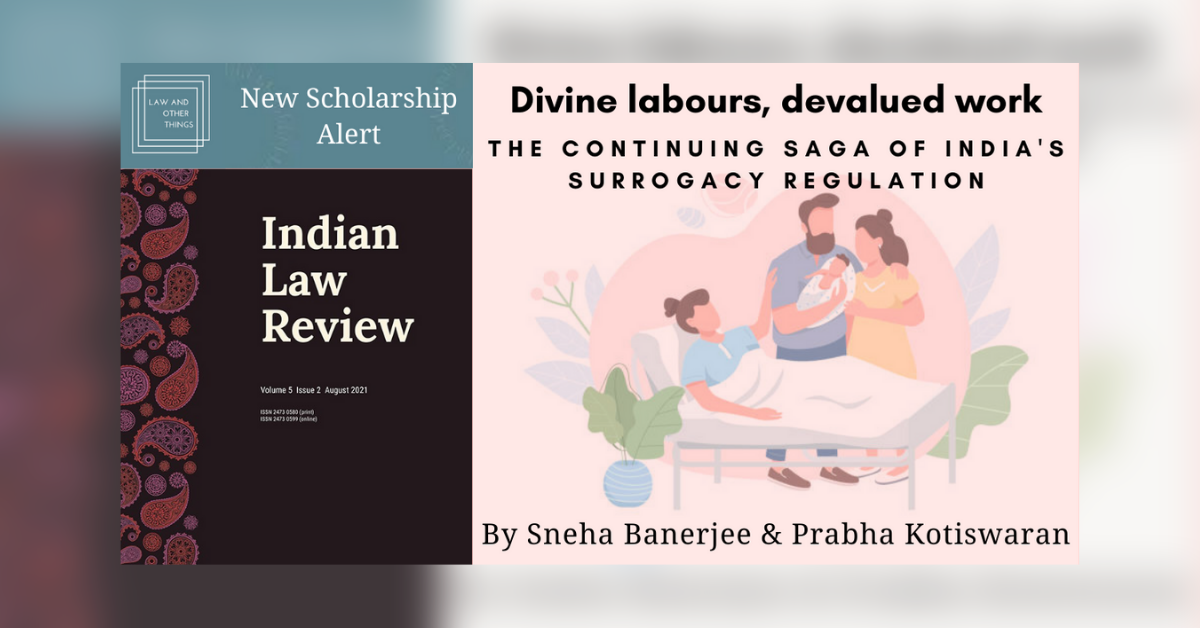Ed Note: As part of our New Scholarship section, we have been inviting discussants to respond to the public law themed articles featured in Volume 5 the Indian Law Review. You can access all the posts in this discussion here. In this post, Sharmila Rudrappa responds to the arguments made by Sneha Banerjee and Prabha Kotiswaran in their paper titled “Divine labours, devalued work: the continuing saga of India’s surrogacy regulation”. You can access the article here and the summary of the paper here.
Sneha Banerjee and Prabha Kotiswaran’s “Divine labours, devalued work” on the convoluted histories, and subsequent analysis of surrogacy regulation in India is a much needed legal intervention on the current Surrogacy (Regulation) Bill, 2019. They begin by broadly mapping fifteen years of regulatory attempts at nationally managing a globalizing, rhizomatic transnational reproductive industry. Each regulation has been overturned with feminists, health activists, medical providers, and somewhere in the mix, bioethicists debating the parameters of each permutation of the bill, until finally, we are now discussing the latest version, Surrogacy (Regulation) Bill, 2019.
Banerjee and Kotiswaran examine and critique the current bill through four lenses. First, they highlight the disarticulation between laws and regulations governing surrogacy and assisted reproductive technologies (ARTs). The processes and social relationships central to ARTs are apparent in surrogacy too, yet regulations for surrogacy are different from that of ARTs, with dis-junctures between stipulations for gamete donors in the legal governance of surrogacy versus ARTs. Banerjee and Kotiswaran next highlight, not just the heterosexist criteria for intending parents and surrogate mothers, but also the intense importance of marriage in that the Bill allows heterosexual couples to seek surrogacy only if they remain childless five years after marriage. Moreover, by restricting surrogacy to only Indian citizens and Overseas Citizens of India who reside outside India, the Bill limits surrogacy to only those who are “racially” Indian; that is, surrogacy accessible to only those with Indian ancestry. This stipulation works particularly well, given that the surrogate mother is expected to be a “close” relative of the intended couple. What is meant by “close,” though, is left open to interpretation. Third, Banerjee and Kotiswaran highlight the anxieties that surround compensation, notably money, that mediate the exchange of a baby for surrogacy services. The Bill bans commercial surrogacy and instead suggests altruism on the part of the surrogate mother who will receive medical expenses and insurance during the time of gestation. And the fourth lens through which Banerjee and Kotiswaran examine the current Surrogacy (Regulation) Bill: its penchant for punishment. The Bill criminalizes a range of actors (doctors, proprietors of clinics, and other intermediaries) for a range of processes in commercial surrogacy, including advertisements, sale of embryos or gametes for surrogacy purposes, and sex selection. The Bill specifies a minimum mandatory punishment of ten years and a fine of up to ten lakh rupees.
While I am in agreement with most of their assessment of this egregiously anti-women Bill, Banerjee and Kotiswaran could have deepened their feminist critiques. They correctly identify the Bill needs to address the needs of the surrogated child, but questionably focus on the child’s biogenetic make-up. They write: “The Bill is silent on whether there should be any genetic link between the intending couple and the child. Many jurisdictions around the world that permit surrogacy insist on such a link, with at least one of the intending parents” (92). I am unsure how such genetic linkages strengthen or weaken a child’s rights. Dismantling love from genetics, I believe, is a feminist ideal and central to an ethics of reproductive justice. Adopted children, who are not genetically descended from their adoptive parents, surely do not suffer from a lack of parental love! In fact, the insistence on such biogenetic links to intended parents (or parent, as the case may be) has degraded children’s rights in the case of transnational surrogacy, as I have learned in my own research, and subsequent conversations with foreign intended parents and surrogacy brokering agents, when international, commercial surrogacy was still legal in India.
When commercial, transnational surrogacy was still legal in India, in order to return to their countries of origin, say the US for example, intended parents needed to apply to their consulate for passports and paperwork to take their newborn(s) home. Such paperwork necessitated cheek swabs to establish genetic linkages between parent and surrogated child. However, I was told that errors were made with labelling either sperm, eggs, or embryos in medical laboratories and the resultant surrogated child bore no genetic relationship to the intended parents, thus annulling any familial connections. The surrogated infant(s) was left without any identifiable genetic parent, and by extension, no single country of origin. They were stateless because India did not confer citizenship on babies born through surrogacy to foreign intended parents. Even though intended parents felt emotionally connected, they had to surrender the child(ren) who then entered into orphanages. I was informed in conversations in 2014-15 with at least two surrogacy brokers that because of the high occurrence of such errors, the US Consulate in Delhi was far more lenient. In the times that the child had no genetic descendance from the intended parents because of clinical errors the consulate simply processed the paperwork in order to restore the child’s rights.
Attention to genetic relatedness to ensure that the child is securely ensconced in the family problematically privileges biology. Instead, conferral of birthright citizenship that automatically confers on a child born in India through surrogacy might be a more effective mechanism for securing rights. Arguably, a child’s citizenship is less of an issue given that most surrogacy is for Indian citizens only; yet, there are Overseas Citizens of India (OCI card holders) travelling in-country for surrogacy purposes for whom this could be a problem.
Second, the question of compensation. In trying to establish a middle ground between alienating commercialism and selfless altruism, Banerjee and Kotiswaran suggest “compensated surrogacy” because anything less than that would amount to forced labour. As I have argued elsewhere, the difference between treating surrogacy as a commodity or a gift is not simply one of exchange of money for a baby, or lack thereof. Instead, such exchanges are distinguished by social relationships. Commodity exchanges most often (though not always) entail momentary, transient connections between buyer and seller, and upon the completion of that exchange, each party goes their own way and will never meet again. Marxian analyses of such exchanges begin with the understanding that the buyer and seller of labour power (in this case, buyers and sellers of gestational labour) hold unequal social power. In spite of apparent twin liberal notions of equality and liberty that adhere to the buyer and seller, the reality is that sellers of labour power almost always end up on the losing side. Unlike commodity exchanges, however, gift exchanges are characterized by ongoing social relationships between the receiver and giver of the gift. Gift-giving relationships might be romanticized as selfless and loving, but they are undergirded too by hierarchical obligations. Caste, class, and gender matter in ways that compel one to give and the other to receive, and shape the sorts of demands one can make on the other’s time, labour, affection, and indeed, body.
Where does Banerjee’s and Kotiswaran’s emphasis on “compensated surrogacy” leave us? I suspect surrogacy in its current form as endorsed by the Bill is patterned on gift-giving especially since the surrogate mother is a “close relative” of the intended parents by legal design. This necessarily means that the two parties have had, and have ongoing social relationships. The surrogate mother, a “close relative” to the intended parents might indeed feel selfless in her sacrificial act of providing gestational labour, but there has to be some recognition that such relationships are inherently gendered and unequal. Can a sister deny her brother gestational labour if access to her inheritance is bound to his largesse (almost every family has stories of daughters receiving lesser property than their brothers). What sorts of obligations might a mother feel toward her childless, married daughter, and what she believes she must do to save that childless marriage, and her daughter from marital abandonment? Might Banerjee and Kotiswaran’s “compensated surrogacy” push the exchange more toward a commodity form wherein the law governs only the act of exchange of gestational labour for a baby, but nothing else in that “close” relationship between the two parties? How is it possible to encapsulate compensation for surrogacy separate from all the other aspects of the two parties’ relationship to each other? Arguably, this is beyond the scope of their argument given that this article is simply a critique of the new Bill. But, the question of compensation (or lack thereof, as in the case of altruistic surrogacy) needs subsequent deeper critical attention.
And finally, I end my engagement with Banerjee and Kotiswaran on a minor quibble. In their concluding section, they urge that India’s surrogacy regulation cannot proceed in a silo; legislators must, they urge, learn from the experiences of a plethora of other countries that have dealt with surrogacy over the past 40 years or so almost since Louise Brown’s birth as the world’s first in-vitro fertilized baby. Yet, as they have so beautifully shown by drawing the readers’ attention to the Bill’s shortcomings, surrogacy regulation in India has hardly even considered the legal milieu within its own borders. Surely, that is a more important point to start as Banerjee and Kotiswaran so beautifully demonstrate? But more to the point, every country has its own specificities with how motherhood is understood, histories of racial/ ethnic marginalization and social movements shape the law, gender mediates everyday life, and when life begins or ends. The argument I want to make is that there is only so much that can be learned through a thorough examination of other nation-states’ surrogacy laws. Israel, with its pronatalist bent, is surely not a model. And most certainly, not the US, where surrogate mothers are now termed “gestational carriers” like they are analogous to postal carriers, or porters of sorts. If anything, India’s engagement with other legislative developments should be about how not to proceed, and what pitfalls we should avoid to have a more equitable legal solution.
The lack of a solid legal framework, in terms of a law on surrogacy, might be a shortcoming. But in that, I believe, there is something to be celebrated. Even today, where dissent in India is more or less kept in check, the topic of surrogacy almost since its inception in India in the early 2000s, has been thickly debated among those on the right and left, feminists, bioethicists, and profit-seeking medical practitioners. Given that I write this commentary residing in the heart of Texas, where abortion is now more or less illegal and women seeking abortions are criminalized for murder, yet commercial surrogacy remains perfectly legal because ARTs and subsequent social arrangements are “pro-life,” I end my commentary on a hopelessly idealistic note: might the lack of an Indian law on surrogacy be something to celebrated?
Sharmila Rudrappa is professor of sociology and director of the South Asia Institute at the University of Texas, Austin. She teaches on, and researches issues related to gender, race, and labour. Her specific interests are on health and society, and reproductive markets in the US and India. She is the author of ‘Discounted Life: The Price of Global Surrogacy in India’ (New York University Press, 2015).






Your point of view caught my eye and was very interesting. Thanks. I have a question for you.